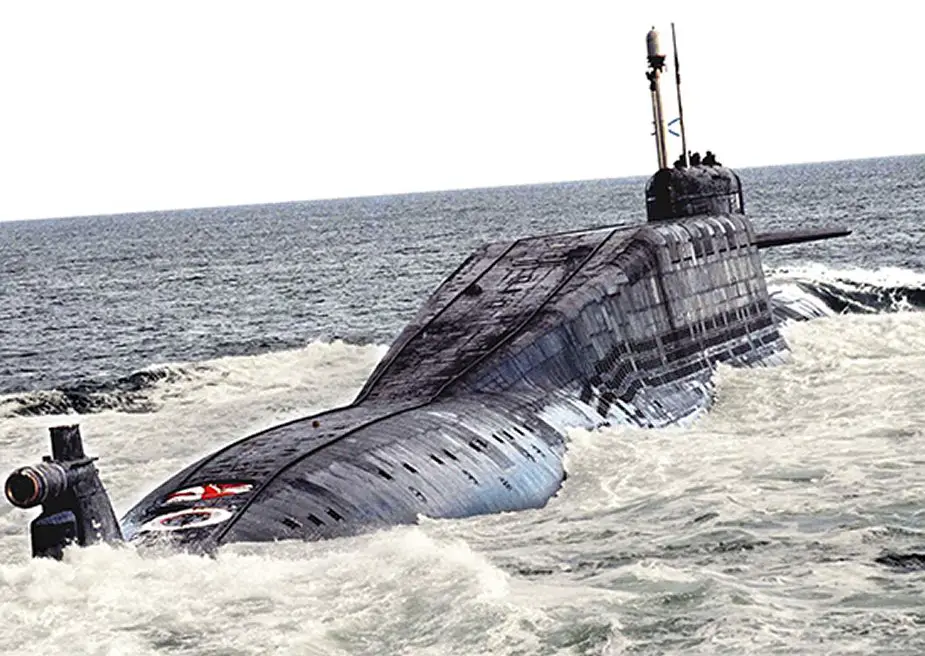Breaking news
Nuclear SSBN submarines of Russian Pacific Fleet conduct ASW mission training.
In accordance with Russian Navy’s combat training plan, two nuclear-powered submarines of the Pacific Fleet conducted a tactical exercise in the Pacific, the Russian Defense ministry annouced on Oct. 13.
Follow Navy Recognition on Google News at this link
 K-44 Ryazan strategic nuclear-powered missile submarine (SSBN) (Picture source: Russian MoD)
K-44 Ryazan strategic nuclear-powered missile submarine (SSBN) (Picture source: Russian MoD)
In particular, the crew of the K-44 Ryazan strategic nuclear-powered missile submarine (SSBN), operating in the combat training range, worked out the search and destruction of a simulated enemy submarine. The Ryazan was opposed by the crew of one of the atomic submarine cruisers of the Pacific Fleet's submarine forces. SSBN "Ryazan" secretly entered the area of the exercise and after finding the "enemy" submarine, conditionally attacked it with anti-submarine weapons. At the same time, the crew worked out the entire algorithm of actions when attacking an underwater enemy, with the exception of the actual torpedo salvo. Further, avoiding a retaliatory attack, the submarine successfully carried out a post-salvo maneuvering.
The K-44 Ryazan was built by the SEVMASH shipyard inat Severodvinsk, launched on January19, 1982, and commissioned on September 17, 1982. It was overhauled in 2007 and in 2012-2017. 155 meter long, its displacement in surface is 10,600 tons, 13,700 tons submerged.
The Project 667BDR Kaľmar (Squid) Delta III-class submarine is a large ballistic missile submarine. Like other previous Delta-class submarines, the Delta III class is a double hulled design, with a thin low magnetic steel outer hull wrapped around a thicker inner pressure hull.
The technical description and requirements for a new ballistic missile submarine were published in 1972. Development of Project 667BDR was begun at the Rubin Central Design Bureau for Marine Engineering[3] under the direction of main designer Sergeiy Nikiticz Kovalev. The submarine was to be a successor to the project 667BD. The Delta III-class subs are significantly quieter and have a higher missile section for newer, longer-ranged missiles.
The hull is divided into ten waterproof sections. The first, third, and tenth sections are emergency sections with escape hatches and transverse struts added to increase pressure resistance. A new modular freon firefighting system was installed. A solarium and gymnasium were to be installed to improve living conditions.
The main propulsion system, OK-700A, consists of two pressurized water reactor VM-4S (2x90 MW) with two steam turbines giving 60,000 shaft horsepower (45,000 kW) to two five-bladed, fixed-pitch shrouded propellers with improved hydro-acoustic characteristics. Two back-up TG-3000 turbogenerators were also installed. Average period between refuelling and overhaul is about ten years.
The Delta III class are fitted with a new sonar system, the MGK-400 Rubikon (in submarine K-424, the older MGK-100 Kerch was installed), developed under the leadership of main designer S.M. Shelechov. The Rubikon can operate in infrasound frequencies, and contains automated systems for target classification. Its maximum range in ideal hydrologic conditions is about 200 km (120 mi). The Delta III class are equipped with a new battle management system, the Almaz-BDR (or MVU-JZBDR) torpedo fire control. For improved stealthiness, a new inertial navigation system, Tobol-M-1 (on newer ships Tobol-M-2), with higher accuracy, was installed. Tobol-M works with data from two observatories which are saved for two days, and also contains a hydro-acoustic navigational station (Shmeľ or "Bumblebee"), which allows the submarine to determine its position from hydro-acoustic buoys. The Delta III class includes the Molnija-M communications system, with satellite capabilities provided by the Tsunami subsystem.
In February 1973, State Rocket Center Makayev began development of a new two-stage liquid-fueled ballistic missile R-29R (3M40, RSM-50, SS-N-18). Improvements in the R-29R over the original R-29 include MIRVed capability and upgraded inertial navigation system with satellite-assisted navigation, giving the new missile greater accuracy (~900 m (3,000 ft)), increasing its damage potential against all types of military targets whether "soft" or "hard." Fire control for the R-29R is achieved through the D-9R ballistic missile system, which contains sixteen SLBM tubes, just like the preceding Project 667BD. The Delta III class most often carried 16 of the R-29R (height: 16.635 m (54.58 ft); diameter: 1.8 m (5.9 ft); starting weight: 36.3 tons) missiles each carrying 3 MIRVs (0.2 мт each) with a range of about 6,500 km (4,000 mi). They also can carry R-29RK with 7 (0.1 мт) MIRVs and range of about 6,500 km or R-29RL with single (0.45 мт) warhead and range of about 9,000 km (5,600 mi). Coupled with the R-29R's capabilities and the performance of the D-9R, the Russian Navy possesses, for the first time, the ability to launch any number of its missiles in a single salvo with shorter launch intervals.
The submarines have four 533mm bow torpedo tubes and carry sixteen torpedoes of types SET-65, SAET-60M, 53-65K, 53-65M, or any combination thereof.


























